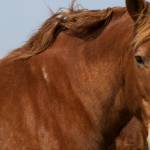New Thoughts on Cresty Necks in Horses

Well-informed horsemen eye cresty necks with suspicion, for an overabundance of neck fat has become a recognized harbinger of metabolic problems, including a risk factor for laminitis. New research* throws doubt on this entrenched belief, suggesting the fat that accumulates along the crest is distinctly different from fat stored in other parts of the body.
Researchers at the University of Bristol assessed nearly 100 grazing horses at the end of winter and at the end of summer, assigning each a cresty neck score (CNS) of 0 (no sign of a crest) to 5 (a crest so large it flops to one side, also known as a “fallen crest”).
Scores were then compared by researchers, and a bewildering trend emerged: scores dropped in the summer and increased in the winter. General fat distribution followed a more typical seasonal response: higher at the end of summer (when forage had been plentiful) and lower at the end of winter (when natural forage had been scarce, with horses relying on preserved forages).
What does this finding mean?
Researchers believe that the physiological function of crest fat might be different than once thought. Instead of mirroring body-wide accumulation, the crest may be a repository for long-term fat storage and thus be immune to changes based on food availability. Another possibility, according to the study authors, involves the sensitivity of the CNS method, which might not be precise enough to measure seasonal fluctuations.
Results of this study opens the door for more research on fat accumulation in horses and its effects on health.
*Giles, S.L., C.J. Nichol, S.A. Rands, and P.A. Harris. 2015. Assessing the seasonal prevalence and risk factors for nuchal crest adiposity in domestic horses and ponies using cresty neck score. BMC Veterinary Research 11:13.








